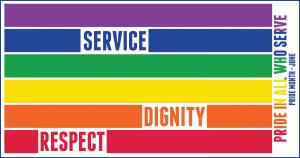By Holly N. O’Reilly, Ph.D.
June 2, 2021
 DoD graphic
DoD graphic
In addition to marking D-Day, the Army Birthday and PTSD Awareness Month, June is also nationally recognized as Lesbian, Gay, Bisexual, Transgender, and Queer (LGBTQ) Pride Month and is a time of celebration for members of these communities. Pride Month honors the Stonewall uprising that began on June 28, 1969, when the Stonewall Inn, a New York City gay club and now National Historic Landmark, was raided by the police. Having endured a history of discrimination, the club’s patrons and local LGBTQ community members decided to stand up for themselves in what is now known as a historic point in the gay rights movement and the beginning of the LGBTQ pride parades that take place in many cities across the country and the world.
The LGBTQ community has achieved significant progress since Stonewall, yet these individuals, including service members, continue to face prejudice and discrimination that is unique to their identities as sexual and/or gender minorities. Such experiences may contribute to the development of mental health conditions and require particular considerations for screening and treatment. Therefore, there is a need for education, knowledge, skill-building, and opportunities for providers to develop confidence and authenticity in working with LGBTQ populations.
Common terms
For mental health providers working with LGBTQ service members, it is helpful to know the definitions of terms that are commonly used to describe various identities and experiences of people within these communities:
Sex – An individual’s sex is typically assigned at birth, or prior to birth using an ultrasound, based on the appearance of external genitalia. This is also referred to as "sex assigned at birth."
Gender – Refers to the psychological, behavioral, social, and cultural aspects of being male or female (i.e., masculinity or femininity) if examining gender through a binary lens.
Gender Identity – An individual’s deeply-felt, inherent sense of being male, female, a blend of both or neither (e.g. genderqueer, gender nonconforming, gender neutral, non-binary, etc.)
Gender expression – An individual’s presentation or external appearance of their gender identity, usually expressed through behavior, clothing, haircut or voice. Gender expression may or may not conform to their gender identity, or to the socially defined behaviors and characteristics typically associated with being either masculine or feminine.
Intersectionality – The experience of belonging to multiple social and political categories or experiencing discrimination based on belonging to multiple social and political categories. For example, each individual belongs to different age, gender, socio-economic, race/ethnicity, sexual orientation, national origin, etc. – each of which may contribute to their experience. These identities overlap providing opportunities for connection but also placing one at risk for discrimination.
Sexual orientation – How an individual characterizes their emotional, romantic and/or sexual attraction to others.
Coming out – The process in which an individual comes to acknowledge and accept their own LGBTQ identity, as well the process of sharing their identity with others. Notably, coming out is a process that members of LGBTQ communities engage in continuously across their lifetimes.
Clinical considerations
When working with LGBTQ service members, it is helpful to keep a few things in mind:
Create a welcoming environment. Placing LGBTQ-specific posters and patient educational materials in your clinic lets patients know the facility is LGBTQ-friendly. LGBTQ health literature is available from the Department of Veterans Affairs and the Centers for Disease Control and Prevention.
Recognize your own biases and assumptions. Each of your LGBTQ patients has to "come out" to family, friends and often co-workers. Many will have to come out numerous times over the course of their lives. If you are heterosexual and/or cisgender, you have not had this experience, and it may be easy for you to underestimate the significance of this event. Take some time to reflect upon your gender and sexual orientation and the impact they have had upon you, your decisions, and your life experiences. Recognize how your assumptions may play out in therapy and realize that greater awareness and understanding of your gender identity and sexual orientation will help you in your work with LGBTQ patients.
Embrace individual differences. Identities are complex. Consider that each person is a unique blend of multiple identities and an individual's gender identity or sexual orientation is only part of their story. Provide space for each service member to tell you the role their sexual orientation or gender identity plays in their lives. Depending upon life stressors, circumstances, and other identities (gender, ethnicity, class, etc.) the LGBTQ identity may be more or less salient from session to session. Don't assume that every session will be dominated by a discussion of sexual orientation but validate and provide support when they share their experiences of discrimination or community.
Provider Resources
Dr. O’Reilly is a clinical psychologist, sexual assault/sexual harassment and inclusive mental health subject matter expert at the Psychological Health Center of Excellence. She specializes in the consequences of trauma, gender studies and inclusive mental health.